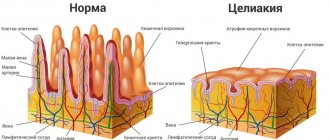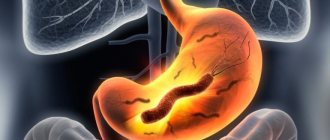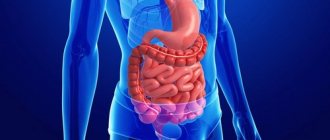Course of the disease
The incubation period of rotavirus is 3-5 days. If the microbe enters a weakened body, the first symptoms will develop within 12 hours. It is enough to ride in the same elevator with a sick neighbor in the evening to wake up in the morning from sudden vomiting.
After two or three attacks of nausea, ending with vomiting, the patient develops diarrhea and the body temperature rises to 39˚C. A serious condition can last up to 4 days, during which a number of recommendations should be followed that will allow you to safely cope with the disease at home, excluding a trip by ambulance to the infectious diseases department.
Symptoms of intestinal flu in adults
Intestinal flu, the symptoms and treatment of which are stressful for the body, always begins suddenly.
The disease is characterized by the following symptoms:
- Diarrhea – loose stools can occur up to 10 times a day. The structure of excrement resembles gruel or foam, possibly mixed with mucus and particles of undigested food. The patient notes increased gas formation. Frequent bowel movements for several days threaten dehydration and subsequent intoxication.
- Abdominal painlocalized in the lower part and/or in the navel area. Painful sensations may intensify upon palpation and are sometimes spastic in nature.
- Nausea and vomiting . The intensity of this symptom may vary from person to person - from mild nausea to repeated vomiting. Frequent vomiting also provokes dehydration and increased other symptoms.
- Increased body temperature - up to 39 degrees. This symptom is a natural protective reaction of the body, whose forces are thrown into the fight against the intestinal flu virus. Typically, the temperature disappears on the second day of illness; in people with weakened immune systems, it can persist for up to 7 days. It is the increase in temperature that indicates the viral nature of the illness and makes it possible to distinguish the disease from food poisoning.
- Catarrhal symptoms (from the ENT organs) - runny nose, sneezing, cough, sore throat. These symptoms appear when infected with adenovirus at the very beginning of the disease. They disappear on their own on the 2-3rd day of illness, without treatment.
- Dehydration is a set of symptoms caused by loss of fluid. Signs of dehydration include weakness, headache and dizziness, respiratory and cardiac problems. There is also pallor or cyanosis of the skin, sharpening of facial features, and “sunken” eyes. If intestinal flu is not treated correctly, they occur on the second day of the disease. However, in elderly people or patients with reduced immunity, signs of dehydration appear 5-6 hours after the onset of the disease.
It is possible that other, atypical signs of the disease will appear. So, when one of the enteroviruses, for example Coxsackie, enters the body, rashes appear on the skin and the lymph nodes become enlarged.
Some symptoms (vomiting, diarrhea, fever) may also indicate the bacterial nature of the intestinal infection. Only a general practitioner can distinguish a virus from a bacteria by prescribing the appropriate laboratory diagnostic test.
Rules for treating intestinal flu
First of all, you need to keep in mind that diarrhea and vomiting are possible when there is food in the gastrointestinal tract. Therefore, the first rule is not to feed the patient. In case of severe hunger, you can take rice porridge cooked in water without adding oil.
The second rule for treating rotavirus infection, which is relevant for any viral disease, is to drink plenty of fluids. Vomiting and frequent loose stools remove all fluid from the body, resulting in life-threatening dehydration. In addition, body temperature rising above 38.5˚C provokes increased sweating, which becomes another source of fluid loss. Replenishing the water-salt balance is more important than taking any medications. The indication for hospitalization is not the severity of the disease, not the degree of fever or the frequency of attacks of diarrhea, but the degree of dehydration. If the patient does not drink, or cannot drink because of vomiting, he is taken to the infectious diseases department, where fluid losses are replenished through a drip.
Routes of infection
Viruses that cause intestinal influenza exist both in the environment and in the human body. Natural bodies of water and soil, as well as an infected person, may become contaminated.
The most common routes of transmission of intestinal infections are:
- airborne (coughing, sneezing, kissing - any close contact);
- fecal-oral (the virus enters the body through dirty hands that have previously been in contact with water, soil or excrement). The virus can be introduced into the body through poorly washed vegetables, fruits, or by swallowing water while swimming in contaminated water;
- household (through objects touched by an infected person).
Once in the external environment, pathogens of intestinal infections contaminate any surfaces - walls and ceilings in rooms, door handles. The highest concentration of the virus can be found on mobile phones, banknotes, dishes, towels and other textiles.
Stomach flu is often called “travelers' illness” - upon arrival on vacation, many people suddenly feel unwell. The virus is introduced into the body, weakened by the long flight and acclimatization, and soon the person begins to suffer from diarrhea and vomiting. However, many people mistakenly attribute these symptoms to food poisoning from unfamiliar food.
Due to its structure (cells lack a lipid membrane), the virus is extremely resistant to external influences.
Thus, infectious agents are not eliminated during wet cleaning with alcohol- and chlorine-containing products, and do not die from exposure to high (up to 60 degrees) temperatures and freezing. This means that if one person in the house gets sick with stomach flu, other members will soon develop symptoms, even despite treatment being started.
Disease severity
The course of intestinal flu depends on the behavior of the patient, as well as on whether the disease was previously suffered. Primary infection is the most severe. Having become infected with rotavirus infection for the first time, the patient suffers from a high fever that does not subside within 3-4 days and incessant diarrhea.
After recovery, antibodies remain in the body, which do not protect against re-infection, but significantly alleviate the course of the disease. Therefore, subsequent episodes of intestinal flu will be either asymptomatic or mild.
Rotavirus intestinal infection in children
Infants do not get intestinal flu because they receive protective antibodies from their mother's milk. But children who are bottle-fed from birth can develop an intestinal infection at 3–6 months.
The incubation period in children occurs in a latent form, lasting up to 5 days. Then the disease enters an acute stage - for 3-8 days the child will suffer from frequent bouts of vomiting, painful abdominal cramps, and upset bowel movements. Rotavirus infection in children occurs against a background of high temperature – 39–40 degrees. All the signs of the flu appear - cough, runny nose, inflammation of the throat and mucous membranes of the eyes.
Diarrhea is the main and most dangerous symptom of the disease; a child may experience attacks more than 10 times a day. On the first day, stool is yellow with a sour odor. In subsequent days, the stool takes on the consistency of clay and has a yellowish-gray color.
The recovery period takes up to 5 days - during this period the child no longer poses a danger to others. The baby may still be bothered by residual intestinal and respiratory effects.
What Dr. Komarovsky says about rotavirus infection:
- intestinal flu cannot be treated on your own - you must call your local pediatrician at home;
- rotavirus infection is a disease of viral origin, therefore it is useless to treat a child with antibiotics;
- the basis of treatment is the fight against dehydration;
- the most dangerous complication is pneumonia, which occurs against the background of a lack of fluid in the body;
- It is forbidden to force-feed sick children - a little fasting will bring greater benefits than eating through force.
To treat intestinal infections in children, drugs against diarrhea are used, to eliminate signs of intoxication, antipyretics, and antispasmodics. During the recovery period, it is imperative to take medications to restore intestinal microflora.
The simplest solution against dehydration can be prepared from 1 liter of warm water, 30 g of sugar, 5 g of salt and 5 g of soda. The child should drink the solution in small portions as often as possible. The optimal amount of urination is once every 3 hours.
Until the child has fully recovered, dairy products are strictly contraindicated - but if the baby is breastfed, he should be fed exclusively with mother’s milk. You should not give your child anything fried or fatty; you will have to give up fruits and juices for a while.
Sources of infection
When someone has discovered an illness associated with an intestinal disorder, they need to be conscientious and isolate themselves from society until the diagnosis is confirmed. The easiest way is to take a stool test for rotavirus. If the result is positive, the patient must limit contact with healthy people for at least 7 days.
Rotavirus is transmitted by airborne droplets. The patient, even while the virus has not manifested itself and is hiding behind the incubation period, is contagious, and therefore dangerous to others. During a conversation or during an accidental sneeze, countless germs fly in different directions and tend to get into someone's respiratory tract.
In addition, infectious disease specialists insist that people remember to wash their hands and food before eating it. The virus remains viable by settling on surfaces. Getting into the mouth from an unwashed apple, it travels throughout the gastrointestinal tract to the intestines, where it begins its active life.
Causes and risk factors
Rotaviruses are a genus of viruses of the reovirus family (Reoviridae), which have double-stranded fragmented RNA. Of the nine known types of rotaviruses, humans can be infected by types A, B and C. Up to 90% of all cases of intestinal influenza are caused by rotavirus A. The diameter of the virion is 65–75 nm. The genome of the virus contains 11 fragments surrounded by a three-layer protein shell (capsid), which makes the virus resistant to the acidic contents of the stomach and intestinal enzymes. The infectious agent is quite stable in the external environment (it easily tolerates low temperatures and heating up to 60 ° C).
Replication of rotaviruses in the body occurs mainly in the enterocytes of the villi of the small intestine, which leads to the death of the latter and subsequent structural and functional changes in the epithelium. The virus enters the cell by direct penetration through the cell membrane or by endocytosis. Due to disruption of the digestive process and the accumulation of disaccharides, a large amount of water and electrolytes enters the intestinal lumen, which leads to the development of severe diarrhea and dehydration of the body.
The infectious agent enters the human body through the mucous membranes of the gastrointestinal tract. The most common route of transmission of the intestinal influenza virus is nutritional (consumption of unwashed vegetables and fruits, meat and dairy products of dubious quality, etc.). Infection by airborne droplets and contact is also possible.
The first signs of intestinal flu are severe nausea, repeated vomiting, rumbling in the stomach, and diarrhea.
Risk factors include immunodeficiency conditions and poor personal hygiene. Intestinal influenza occurs both sporadically and in epidemic outbreaks. Foci of infection often occur in children's groups, especially in preschool institutions, in children hospitalized in a hospital for another reason (nosocomial infection), as well as in nursing homes.
Do I need a diet after recovery?
As a rule, a return to normal life is possible after the main symptoms disappear. When the temperature has stopped rising, nausea has disappeared and intestinal upset is no longer bothering you, you can begin to eat properly.
On the first day, you should still be careful when creating a menu, limiting the size of your usual portions. If diarrhea does not return, nutrition can be completely restored.
However, it is rotavirus that has one feature that forces you to make some adjustments to your diet. Having suffered from intestinal flu disrupts the enzymatic activity of the digestive organs, which is why a person loses the ability to digest lactose. In this connection, a diagnosed rotavirus infection becomes an indication to exclude products that contain milk or lactose. This diet should be followed for two weeks. After the specified period has expired, lactase deficiency will disappear, digestive function will be restored, and you can return to your usual menu.
Rotavirus in infants
Children of the first year of life are susceptible to infection from the age of 6 months. The course of the disease and recovery time do not differ from those in adults. High fever and diarrhea persist for 3-4 days. Vomiting, as a rule, occurs once, at the very beginning of infection. A small child is also contagious to others, so it is important to protect him from communicating with children on the playground or in kindergarten.
After recovery, parents need to switch the child to a lactose-free formula to eliminate pain in the abdominal area. It will take 9 to 14 days before digestive functions are restored. After which the child can be returned to natural feeding or an adapted milk formula.
Causes
Often the disease occurs when eating unwashed fruits; they become infected with an intestinal virus through insufficient processing of meat and dairy products, through dirty hands and water. Bacterial causes of infection:
- coli;
- Shigella;
- salmonella.
Viral causes:
- caliciviruses;
- noroviruses;
- adenoviruses;
- astroviruses.
Parasitic causes are also known. Parasites are tiny microorganisms. They rarely cause influenza. More often, infection occurs with Giardia or Cryptosporidium. Similar symptoms can be caused by chemical toxins, heavy metals, and specific medications (aspirin, antibiotics, steroids, laxatives).
- Eggplants with tomatoes and garlic in the oven - recipes for the table and for the winter
- How to permanently delete a Facebook page without recovering your account
- Acipol - instructions for use. How to take Acipol for adults and children with diarrhea and dysbacteriosis











